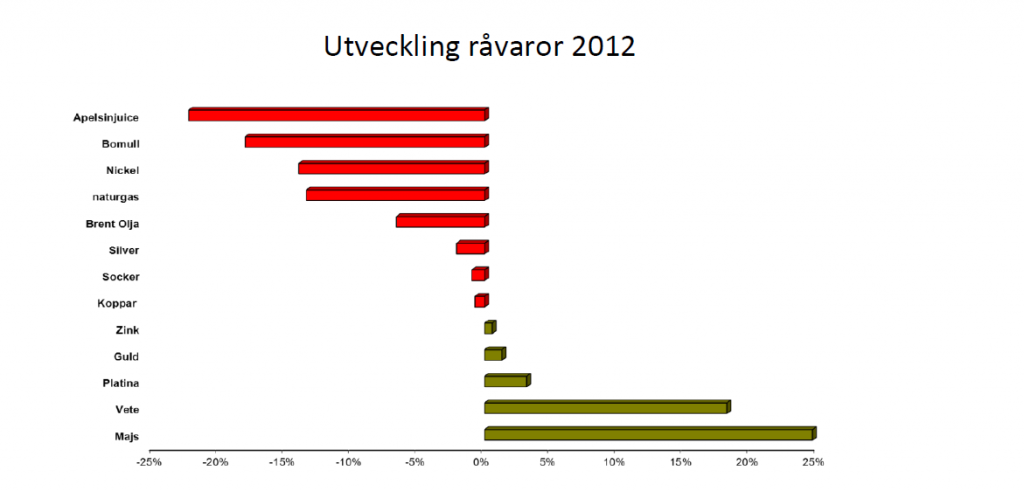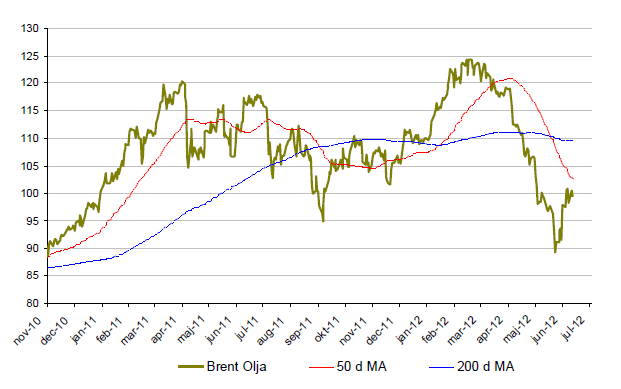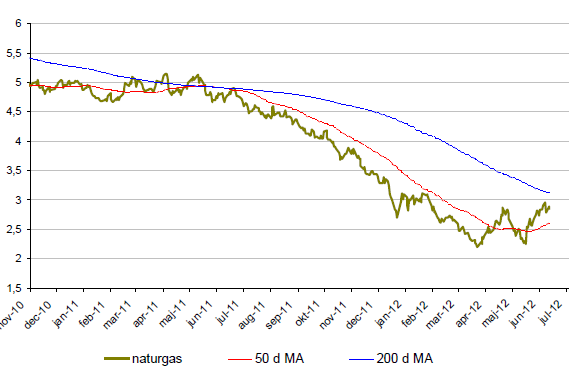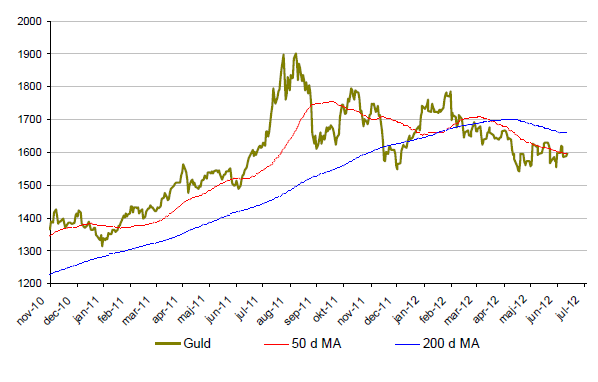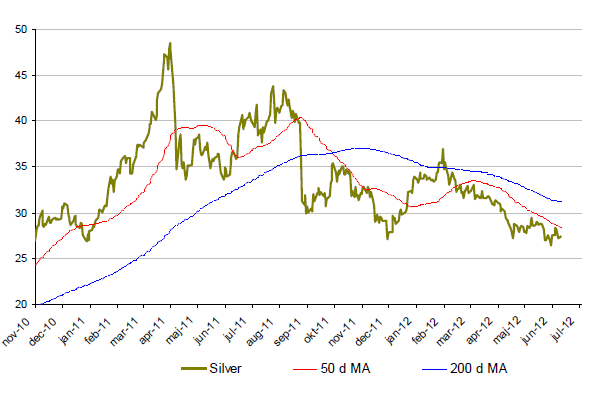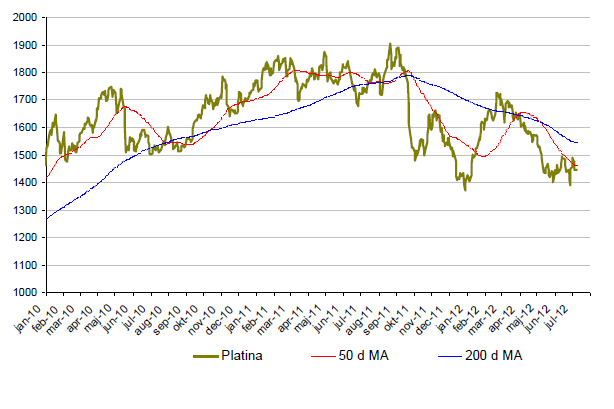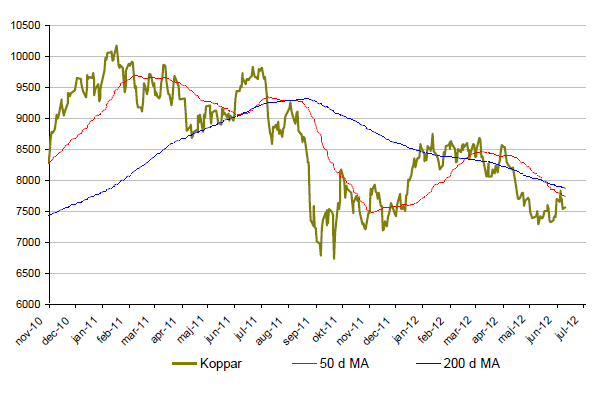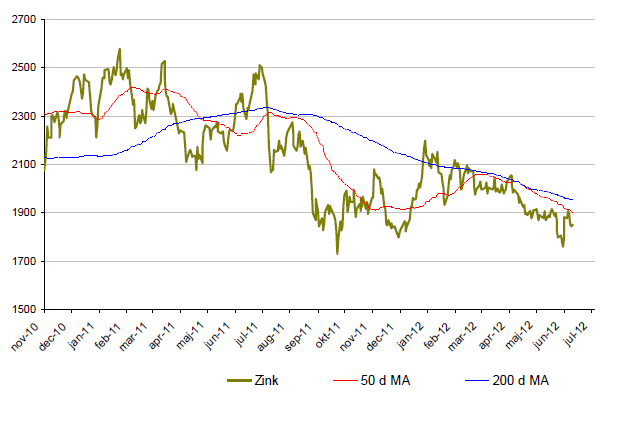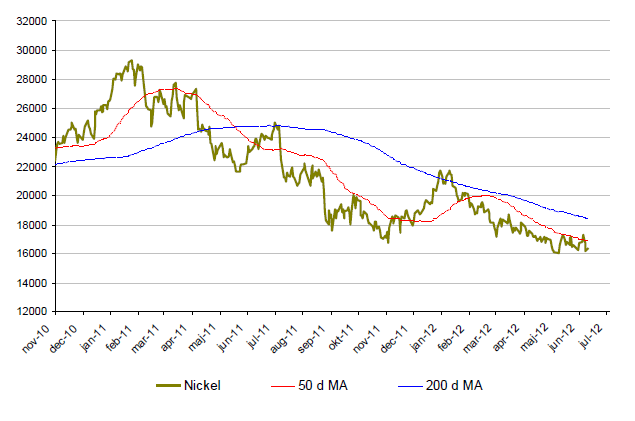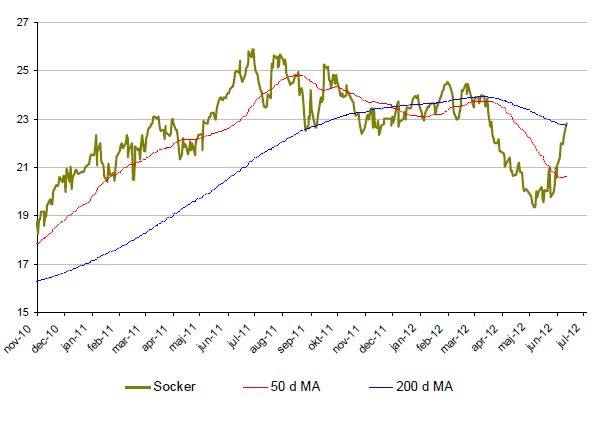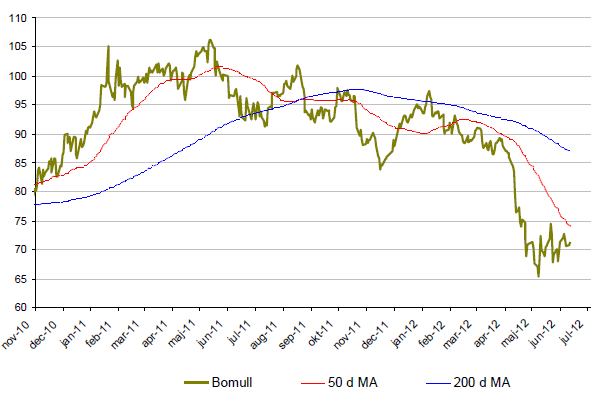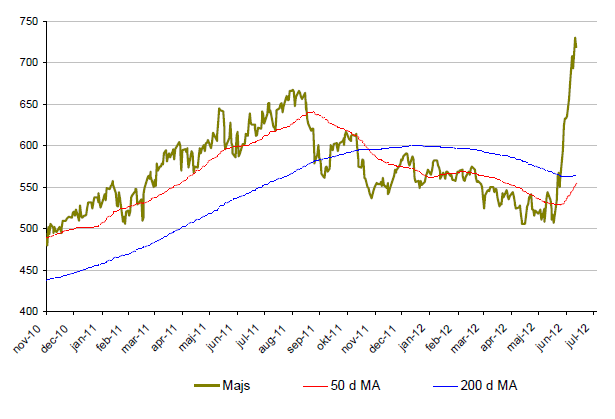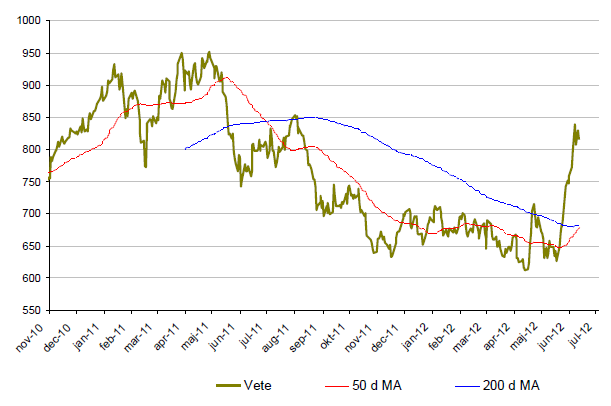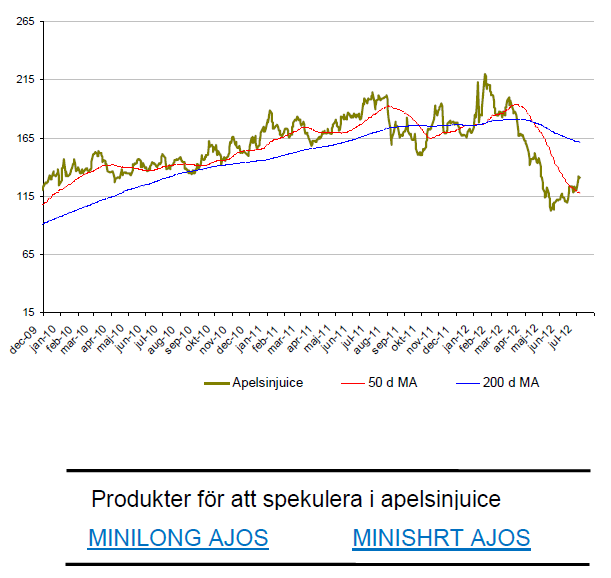Analys
SIP Nordic – Råvaruguiden – juli 2012
 Likt bolagen på Stockholmsbörsen är det nu dags att summera det första halvåret för råvarorna. Det har varit ett spännande halvår med många och stora svängningar. Många råvaror startade året starkt för att under andra kvartalet falla tillbaka ordentligt.
Likt bolagen på Stockholmsbörsen är det nu dags att summera det första halvåret för råvarorna. Det har varit ett spännande halvår med många och stora svängningar. Många råvaror startade året starkt för att under andra kvartalet falla tillbaka ordentligt.
Råvarupriserna har föga förvånande påverkats av det rådande börsklimatet med greklandsoro och en svajig eurokurs.
Brent-oljan lyckades inte hålla sig kvar på de höga noteringarna kring 120$ och har nu fallit tillbaka och handlas under 100$.
Jordbruksråvarorna vete oh majs har fått ett ordentligt uppsving efter en trevande start på året. Lika bra går det inte för apelsinjuice som efter en uppgång på närmare 200 % sedan 2009 har tappat nästan 25 % på ett halvår.
I den första utgåvan av Råvaruguiden skrev jag att jag trodde på guld och platina. De är fortfarande på plus men det ska bli mycket intressant att följa guldets utveckling de kommande fem, sex månaderna.
Guldpriset ligger något högre än vid årets början men med en starkare dollarkurs kontra euron finns risken att guldpriset för första gången på tio år får en negativ årsutveckling.
Råvaror – Energi
Brent olja
- Trotts återhämtningen i månadsskiftet juni/juli är brent-oljan ned nästan 12 % för året.
- Brent har sedan slutet av juni stigit med nästan 12 %.
- Strejk i Norge driver den nuvarande kursriktningen.
- Under juli har OPEC ett mycket viktigt möte i Wien huruvida de ska skära i produktionskvoterna. Senast de gjorde detta var 2008 då brent-oljan tappade närmare 75 %.
Naturgas
- Naturgas har återhämtat sig ordentlig och är nu ”endast” ned dryga 6 % för året.
- Sedan i mitten av april har priset på naturgas stigit med nästan 50 %.
- En stor anledning till uppgången är att många spekulanter, däribland hedgefonder ligger i korta positioner. Detta kan fortsatt driva priset uppåt.
- Lagren av naturgas väntas öka under 2012 med 26 %.
Råvaror – Metaller
Guld
- Under juni är guld upp närmare 2 %
- För året är guld upp 1,5 %.
- Guldpriset har de senaste tio åren haft en positiv årsutveckling. Risken finns att det kan bli ett negativt resultat 2012.
- Guldpriset har i år varit starkt korrelerad med hur den europeiska och amerikanska centralbanken har agerat.
- Den amerikanska centralbanken har i slutet av juli ett mycket viktigt möte. Ett eventuellt QE3 kan få guldet att röra på sig ordentligt.
Silver
- Silver är för året ned dryga 1 %.
- Sedan slutet av februari har silver tappat mer än 25 %.
- Silverproduktionen väntas öka 4 % under 2012.
- Överskottet av silver väntas i slutet av 2012 bli smått otroliga 5060 ton.
- Den europiska kreditkrisen i kombination med rädsla för minskad kinesisk tillväxt bidrar till de negativa sentimenten i silver.
- Likt guldet blir den amerikanska centralbankens möte i juli mycket viktigt för silvers framtida kursrörelse.
Platina
- Platina är för året upp nästan 5 %.
- Sedan toppen i februari har dock platina tappat nästan 17 %.
- Platina fortsätter at handlas till en billigare kurs än guld.
- Efter strejken vid Rustenburggruvan i Sydafrika ökar nu lagren av platina samtidigt som efterfrågan minskar.
- Producenter av platina kämpar därför med krympande marginaler,
Koppar
- För året är kopparpriset ned 2 %.
- Trots att kopparinventarierna ligger på rekordlåga nivåer fortsätter koppar i sin långsiktigt negativa trend.
- Den största risken ligger i att Kina, med 40 % av världskonsumtionen, står inför en minskande tillväxt.
Zink
- Zink är nu tillbaka på ruta ett för året. +-0 %.
- Likt andra metaller har zinkpriset fallit kraftigt sedan månadsskiftet januari/februari.
- Tillgången på zink är stort och priset påverkas negativt av rapporter om stigande lager. Detta kan trycka ned priset ytterligare.
- Kina är återigen en viktig bricka i spelet. En minskad tillväxt i Kina kommer troligtvis ha en betydande effekt på zinkpriset. Kina står för 43 % av världens konsumtion.
Nickel
- Nickel presterade sämst av alla basmetaller under 2011.
- Nickel fortsätter sin kräftgång under 2012 är för året ned nästan 13 %.
- Sedan toppen i februari har nickel tappat mer än 27 %.
- Nickelmarknaden är mättad med ökande lager.
- Många stora projekt inom nickelproduktion är redan finansierade och irreversibla vilket kommer att öka tillgången av nickel ytterligare.
Råvaror – Jordbruk
Socker
- Jordbruksråvarorna har haft en stark sommarutveckling. Så också socker.
- Sedan början av juni är socker upp närmare 20 %.
- För året är dock sockerpriset ned dryga 3 %.
- Många spekulanter ligger fel i sina positioner. Många hedgefonder ligger i stora korta positioner vilket pressar priset på socker uppåt.
Bomull
- Bomull är för året ned ca 24 % där merparten av nedgången kom i maj. I maj föll bomullspriset med närmare 20 %.
- Rekordexport av bomull från Indien pressar priset.
- Trots att bomullspriset fallit kraftigt under 2012 är det fortfarande nästan dubbelt så högt som priset för några år sedan. Fallhöjden är således stor.
Majs
- Priset på majs har ökat kraftigt sedan i börjanav juni. +38 %.
- För året är majs upp 18 %.
- Tidigare spekulationer visade att skörden av majs i USA skulle vara mycket god. Extrem torka gör dock att kommande skörd ser ut att vara mycket dålig vilket driver priset på majs till de högsta nivåerna sedan juni 2011.
- Knappt 50 % av skörden spås vara av god kvalitet.
Vete
- Likt majs rusade vete under juni månad. Upp nästan 33 % sedan mitten av juni.
- För året är priset på vete upp 25 %.
- Torkan i USA gör att den kommande skörden inte blir så stor som förutspått.
- Gemensamt för både majs och vete är att de kraftiga uppgångarna skett mycket snabbt vilket kan resultera i en liten rekyl nedåt innan priset fortsätter uppåt igen.
Apelsinjuice
- Sedan i maj har priset på apelsinjuice återhämtat sig en del. + 30 % sedan i mitten av maj.
- Trots detta är apelsinjuice ned nästan 25 % för året.
- Priset på apelsinjuice är fortfarande dubbelt så högt som botten 2009. Fallhöjden är således hög.
[box]Denna uppdatering är producerat av SIP Nordic och publiceras i samarbete och med tillstånd på Råvarumarknaden.se[/box]
Ansvarsbegränsning
Detta produktblad utgör endast marknadsföring och har sammanställts av SIP Nordic Fondkommission AB.
Innehållet ger inte fullständig information avseende det finansiella instrumentet. Investerare uppmanas att del av prospekt och slutliga villkor, vilka finns tillgängliga på: www.rbsbank.se/markets, innan ett investeringsbeslut tas.
Förekommande exempel är simulerade och baseras på SIP Nordics egna beräkningar och antaganden, en person som använder andra data eller antaganden kan nå andra resultat. Administrativa avgifter och transaktionsavgifter påverkar den faktiska avkastningen.
Analys
Tightening fundamentals – bullish inventories from DOE

The latest weekly report from the US DOE showed a substantial drawdown across key petroleum categories, adding more upside potential to the fundamental picture.

Commercial crude inventories (excl. SPR) fell by 5.8 million barrels, bringing total inventories down to 415.1 million barrels. Now sitting 11% below the five-year seasonal norm and placed in the lowest 2015-2022 range (see picture below).
Product inventories also tightened further last week. Gasoline inventories declined by 2.1 million barrels, with reductions seen in both finished gasoline and blending components. Current gasoline levels are about 3% below the five-year average for this time of year.
Among products, the most notable move came in diesel, where inventories dropped by almost 4.1 million barrels, deepening the deficit to around 20% below seasonal norms – continuing to underscore the persistent supply tightness in diesel markets.
The only area of inventory growth was in propane/propylene, which posted a significant 5.1-million-barrel build and now stands 9% above the five-year average.
Total commercial petroleum inventories (crude plus refined products) declined by 4.2 million barrels on the week, reinforcing the overall tightening of US crude and products.


Analys
Bombs to ”ceasefire” in hours – Brent below $70

A classic case of “buy the rumor, sell the news” played out in oil markets, as Brent crude has dropped sharply – down nearly USD 10 per barrel since yesterday evening – following Iran’s retaliatory strike on a U.S. air base in Qatar. The immediate reaction was: “That was it?” The strike followed a carefully calibrated, non-escalatory playbook, avoiding direct threats to energy infrastructure or disruption of shipping through the Strait of Hormuz – thus calming worst-case fears.

After Monday morning’s sharp spike to USD 81.4 per barrel, triggered by the U.S. bombing of Iranian nuclear facilities, oil prices drifted sideways in anticipation of a potential Iranian response. That response came with advance warning and caused limited physical damage. Early this morning, both the U.S. President and Iranian state media announced a ceasefire, effectively placing a lid on the immediate conflict risk – at least for now.
As a result, Brent crude has now fallen by a total of USD 12 from Monday’s peak, currently trading around USD 69 per barrel.
Looking beyond geopolitics, the market will now shift its focus to the upcoming OPEC+ meeting in early July. Saudi Arabia’s decision to increase output earlier this year – despite falling prices – has drawn renewed attention considering recent developments. Some suggest this was a response to U.S. pressure to offset potential Iranian supply losses.
However, consensus is that the move was driven more by internal OPEC+ dynamics. After years of curbing production to support prices, Riyadh had grown frustrated with quota-busting by several members (notably Kazakhstan). With Saudi Arabia cutting up to 2 million barrels per day – roughly 2% of global supply – returns were diminishing, and the risk of losing market share was rising. The production increase is widely seen as an effort to reassert leadership and restore discipline within the group.
That said, the FT recently stated that, the Saudis remain wary of past missteps. In 2018, Riyadh ramped up output at Trump’s request ahead of Iran sanctions, only to see prices collapse when the U.S. granted broad waivers – triggering oversupply. Officials have reportedly made it clear they don’t intend to repeat that mistake.
The recent visit by President Trump to Saudi Arabia, which included agreements on AI, defense, and nuclear cooperation, suggests a broader strategic alignment. This has fueled speculation about a quiet “pump-for-politics” deal behind recent production moves.
Looking ahead, oil prices have now retraced the entire rally sparked by the June 13 Israel–Iran escalation. This retreat provides more political and policy space for both the U.S. and Saudi Arabia. Specifically, it makes it easier for Riyadh to scale back its three recent production hikes of 411,000 barrels each, potentially returning to more moderate increases of 137,000 barrels for August and September.
In short: with no major loss of Iranian supply to the market, OPEC+ – led by Saudi Arabia – no longer needs to compensate for a disruption that hasn’t materialized, especially not to please the U.S. at the cost of its own market strategy. As the Saudis themselves have signaled, they are unlikely to repeat previous mistakes.
Conclusion: With Brent now in the high USD 60s, buying oil looks fundamentally justified. The geopolitical premium has deflated, but tensions between Israel and Iran remain unresolved – and the risk of missteps and renewed escalation still lingers. In fact, even this morning, reports have emerged of renewed missile fire despite the declared “truce.” The path forward may be calmer – but it is far from stable.
Analys
A muted price reaction. Market looks relaxed, but it is still on edge waiting for what Iran will do

Brent crossed the 80-line this morning but quickly fell back assigning limited probability for Iran choosing to close the Strait of Hormuz. Brent traded in a range of USD 70.56 – 79.04/b last week as the market fluctuated between ”Iran wants a deal” and ”US is about to attack Iran”. At the end of the week though, Donald Trump managed to convince markets (and probably also Iran) that he would make a decision within two weeks. I.e. no imminent attack. Previously when when he has talked about ”making a decision within two weeks” he has often ended up doing nothing in the end. The oil market relaxed as a result and the week ended at USD 77.01/b which is just USD 6/b above the year to date average of USD 71/b.

Brent jumped to USD 81.4/b this morning, the highest since mid-January, but then quickly fell back to a current price of USD 78.2/b which is only up 1.5% versus the close on Friday. As such the market is pricing a fairly low probability that Iran will actually close the Strait of Hormuz. Probably because it will hurt Iranian oil exports as well as the global oil market.
It was however all smoke and mirrors. Deception. The US attacked Iran on Saturday. The attack involved 125 warplanes, submarines and surface warships and 14 bunker buster bombs were dropped on Iranian nuclear sites including Fordow, Natanz and Isfahan. In response the Iranian Parliament voted in support of closing the Strait of Hormuz where some 17 mb of crude and products is transported to the global market every day plus significant volumes of LNG. This is however merely an advise to the Supreme leader Ayatollah Ali Khamenei and the Supreme National Security Council which sits with the final and actual decision.
No supply of oil is lost yet. It is about the risk of Iran closing the Strait of Hormuz or not. So far not a single drop of oil supply has been lost to the global market. The price at the moment is all about the assessed risk of loss of supply. Will Iran choose to choke of the Strait of Hormuz or not? That is the big question. It would be painful for US consumers, for Donald Trump’s voter base, for the global economy but also for Iran and its population which relies on oil exports and income from selling oil out of that Strait as well. As such it is not a no-brainer choice for Iran to close the Strait for oil exports. And looking at the il price this morning it is clear that the oil market doesn’t assign a very high probability of it happening. It is however probably well within the capability of Iran to close the Strait off with rockets, mines, air-drones and possibly sea-drones. Just look at how Ukraine has been able to control and damage the Russian Black Sea fleet.
What to do about the highly enriched uranium which has gone missing? While the US and Israel can celebrate their destruction of Iranian nuclear facilities they are also scratching their heads over what to do with the lost Iranian nuclear material. Iran had 408 kg of highly enriched uranium (IAEA). Almost weapons grade. Enough for some 10 nuclear warheads. It seems to have been transported out of Fordow before the attack this weekend.
The market is still on edge. USD 80-something/b seems sensible while we wait. The oil market reaction to this weekend’s events is very muted so far. The market is still on edge awaiting what Iran will do. Because Iran will do something. But what and when? An oil price of 80-something seems like a sensible level until something do happen.
-

 Nyheter4 veckor sedan
Nyheter4 veckor sedanStor uppsida i Lappland Guldprospekterings aktie enligt analys
-

 Nyheter4 veckor sedan
Nyheter4 veckor sedanSilverpriset släpar efter guldets utveckling, har mer uppsida
-

 Nyheter3 veckor sedan
Nyheter3 veckor sedanUppgången i oljepriset planade ut under helgen
-

 Nyheter3 veckor sedan
Nyheter3 veckor sedanLåga elpriser i sommar – men mellersta Sverige får en ökning
-

 Nyheter2 veckor sedan
Nyheter2 veckor sedanMahvie Minerals växlar spår – satsar fullt ut på guld
-

 Analys3 veckor sedan
Analys3 veckor sedanVery relaxed at USD 75/b. Risk barometer will likely fluctuate to higher levels with Brent into the 80ies or higher coming 2-3 weeks
-

 Nyheter1 vecka sedan
Nyheter1 vecka sedanOljan, guldet och marknadens oroande tystnad
-

 Nyheter1 vecka sedan
Nyheter1 vecka sedanJonas Lindvall är tillbaka med ett nytt oljebolag, Perthro, som ska börsnoteras


